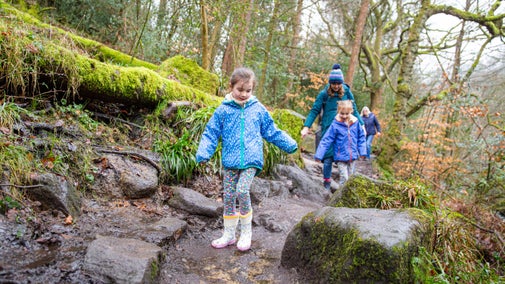
Donate
Everyone needs nature, now more than ever. Donate today and you could help people and nature to thrive at the places we care for.

The fields around Hardcastle Crags are home to some incredibly rare species of fungi. As part of the Grassland Fungi Project, the National Trust is working with local landowners to look after these important ecosystems.
With names like Apricot Club, Purple Coral and Deceptive Earthtongue, the world of fungi is weird and wonderful. Many of these incredibly rare fungi are on threatened species lists, as they only grow in very specific conditions. Luckily, they are thriving in parts of Calderdale.
Two species – Glutinoglossum triseptatum and Camarophyllopsis atrovelutina, or Dark Velvet Fanvault – were spotted for the first time in the country in the National Trust's Grassland Fungi Project. The project studied ancient grasslands around Hardcastle Crags and found them to be of international significance for the range of fungi present. Surveys and DNA testing are ongoing with regard other potential new species.
The meadows and grasslands that surround Hardcastle Crags are incredibly important for biodiversity. Many have been farmed with traditional methods for years, using few modern fertilisers and with a focus on grazing and hay making.
The ancient grasslands here are perfect for rare fungi, especially those with moist but well-draining soil. With its steep valley sides and frequent Pennine rainfall, Calderdale is a haven for some of the most threatened species of fungi.
Since the 1940s, 97 per cent of ancient grasslands in the UK have been lost due to changing farming practices, most of them surviving in the uplands but still prone to loss due to climate change and atmospheric pollution.
Working with private landowners to complete studies of fields around Calderdale, the National Trust found 94 species of the particular fungi that help identify ancient grassland – land which has been left to develop over centuries without consistent management. Many sites met criteria for potentially becoming a site of special scientific interest (SSSI) based on their range of fungi.
These fungal ecosystems can take hundreds of years to form, but once established, the fungi can then live for hundreds of years.
If you see fungi growing in a field, it indicates the soil is in very good health and less compacted. This also plays a part in reducing flood risk, as less compacted soil can help to slow the flow of water off the valley sides.
Ancient grasslands are also important stores of carbon owing to the complex nutrient trading process that takes place between fungi and plants or trees. Fungi are able to move nutrients through soil, improving the habitat's resilience, while also locking carbon underground which would otherwise be vulnerable to release into the environment.

Many traditional, unimproved grasslands have changed dramatically over the last century.
New farming technologies and chemicals mean many fields have been changed to make them more productive, but this has had a knock-on effect on biodiversity and species like fungi.
Many of the fungi found in Calderdale are on the UK and EU Red data lists for threatened species.
It's still not fully understood how they can play a part in our own health. Many of them could provide medicines or solutions for problems we've not even thought of yet.
Tree planting, whilst an important tool in the fight against climate change, can also threaten the delicate balance of these habitats. The Trust believes in planting the right trees in the right place, but also want to show just how valuable unimproved grasslands are to help capture carbon.
The aim of the Grassland Fungi Project is to identify key sites where these fungi grow and working with farmers to maintain these habitats.
The Trust will be working with partners the Colne and Calder Rivers Trust and following advice from Natural England. This project is not just about National Trust land, it’s about working with landowners and farmers throughout Calderdale.
If you see a bright, shiny golden waxcap or the red of a scarlet waxcap on your next walk, please let us know. Ancient grasslands typically looks brownish-green during autumn and have many different species of grasses and flowers.

Everyone needs nature, now more than ever. Donate today and you could help people and nature to thrive at the places we care for.

Natural England is the government’s adviser for the natural environment in England. They help to protect and restore our natural world.
Discover how the National Trust are working to manage woodland, and in doing so improving habitats for wildlife, limiting flooding and reducing our carbon footprint.

With 15 miles of footpaths to explore in the beautiful Yorkshire countryside, there's lots to discover on a walk at Hardcastle Crags.

Learn about the history and evolution of the landscape at Hardcastle Crags and Gibson Mill, including its industrial heritage and the mill’s time as an entertainment emporium.

We believe that nature, beauty and history are for everyone. That’s why we’re supporting wildlife, protecting historic sites and more. Find out about our work.
